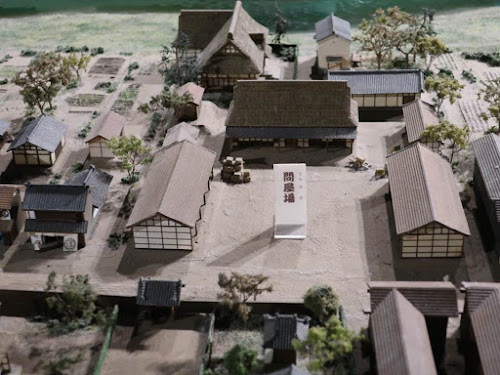Kasukabe was a post town on Nikkou-doucyuu highway which connected Edo(old name of Tokyo) and Nikkou where the shrine dedicated to the first Tokugawa shogun is. Kasukabe is located about 35km north of Tokyo.
This
museum shows you the history of Kasukabe since ancient times. The attractive
exhibit is a model of Kasukabe post town in the end of the Edo period (1:200
model). The panels of the post town help you to understand the people’s lives
there. There were many shops including pubs and there was a silly son who was
into sake (alcohol). You can get on a palanquin, wear an armor (helmet) and
straw shoes, and you can play using old style toys.
 |
| Exhibition room、展示室 |
縄文時代からの春日部(埼玉県)の歴史が展示されている。江戸時代末期の日光街道・奥州街道の粕壁(かすかべ)宿について、模型(1/200)とパネル展示と合わせて良く分かるようになっている。広さは、教室3つほどで丁度良い。籠に乗ったり、兜をつけたり、昔のおもちゃで遊んだり、草鞋をはいたり、体験できるようになっている。教育センターの中に郷土資料館がある。人の楽しみの面からみると、宿場には居酒屋はじめさまざまなお店があって賑わっていたこと、そんな中で酒好きの放蕩息子もいたことなど、人間味があって面白い。
The photo below is a full-scale model of the house around 4800 years ago. You touch the pieces of earthenware.
The
exhibition area of the Middle Age; Kasukabe clan ruled this area and Satte
Fudou temple had a big power then.
In the Edo period, Nikkou highway was
constructed. The Nikkou shrine was completed in 1639 which is one of the most
famous tourist attraction and UNESCO World Heritage Site. Nikkou shrine is
really gorgeous;
Some carpenters who were engaged in
building the shrine lived in Kasukabe. They
learned high-level woodwork in the project. They started making furniture such
as chests of drawers of paulownia wood. Kasukabe has been famous for chests since then. By the way, paulownia
wood is expensive but it is used for furniture often in Japan because it is
light and fire-proof.
The
photo above is an assumed model of Kasuabe early 19th century. There
are 159 buildings including two inns for daimyo lord called “Honjin”, tree
village heads’ residences and 45 inns.
1800~1850年で設定した宿場想定模型。街並み159軒で、本陣1軒、脇本陣1軒、名主3軒、旅籠45軒が作られている。
This
facility is responsible for logistic and post system. There were 35 horses in a
courtyard; I felt the bustle and vitality.
 |
| Toiyaba、問屋場 |
荷物や郵便を扱う問屋場。馬や荷物を置くせいか、立派な広場がある。賑わいを感じます。35匹の馬を確保していたらしいです。
 |
| Large house of a village head、名主の家は敷地が広い |
 |
| Population of post towns on Nikkou highway、日光道中の宿場町 |
粕壁は、人口3700人で千住に次ぐ二番手グループ。
In the center of Kasukabe post town, there were Nikkou highway which width was 9m. The town was along the highway and the length was 1.1km. There were 114 restaurants and pubs along the street, so in every 24 meters there was a restaurant or pub. There were also sweets shops; four candy shops, three mochi cake shops and seven fruit shops. Kasukabe is around 35km away from the sea, however there was a sushi restaurant; sushi has been popular. Ten massagers and three public bath houses, which described in the dairy of Isabella Bird who traveled Japan around 150 years ago, were there. By the way, the average number of a family member was less than five; it wasn’t so large. I could imagine daily life of the ordinary people.
 |
| Livelihoods and number of houses of each job in 1849、嘉永二年の職業構成 |
In the center of Kasukabe post town, there were Nikkou highway which width was 9m. The town was along the highway and the length was 1.1km. There were 114 restaurants and pubs along the street, so in every 24 meters there was a restaurant or pub. There were also sweets shops; four candy shops, three mochi cake shops and seven fruit shops. Kasukabe is around 35km away from the sea, however there was a sushi restaurant; sushi has been popular. Ten massagers and three public bath houses, which described in the dairy of Isabella Bird who traveled Japan around 150 years ago, were there. By the way, the average number of a family member was less than five; it wasn’t so large. I could imagine daily life of the ordinary people.
粕壁宿は、道幅5間(9m)の10町余り(1.1km)の道に家々が並んでいた。嘉永2年(1849年)で、人口3.779人、戸数817戸であった。一戸5人弱だ。大きな家もあるのに、意外と少ない。飲食店は46軒ある。24mに一軒の割だ。スイーツ系が多い。飴菓子が4軒、餅菓子が3軒、水菓子はおそらく果物屋で7軒。海から遠いのにすし屋があるのがおもしろい。江戸の人は鮨が好きか。イザベラバードの日記に出てくる按摩もいるし、湯屋も3軒ある。人びとの暮らしを感じる。
 |
| Letter of apology、詫び状 |
運送屋の息子が、荷物の酒1駄を自宅に運び込んだことに対する、主人の詫び状。金目のものより重い酒を盗んだのが面白い。バカ息子はいつの時代もいるものだ。
 |
| Sugoroku or Japanese backgammon/Copy 日光・三社・成田山廻り滑芸振分双六」複製 |
1842年の双六の複製。名前が面白い。コースは分かれるが、上りは何れも日光東照宮となる。服を脱いで踊っている男もいて、旅は楽しそう。拡大してみていただきたい。
The
photo below is a palanquin you can get on. There are also many toys you can
play with. 体験コーナーの駕籠。乗れるようになっている。おもちゃもたくさんある。
Straw shoes which were used in the Edo period. It is amazing that
people walked 40km a day using this kind of shoes in winter. 草履。これで一日40kmも歩いたのだから、偉い。しかも農民は冬の旅だ。
Folklore of Kasukabe are introduced by posters. Kite flying which is held at
Edogawa riverside is also shown.
「春日部の民俗」として祭りの紹介パネル。GWに江戸川河川敷で行われる大凧あげの紹介もあった。
「春日部の民俗」として祭りの紹介パネル。GWに江戸川河川敷で行われる大凧あげの紹介もあった。
 |
| Brochure of the big kite flying、大凧揚げのリーフレットから |
【Thematic exhibition: Transportation and logistics after the Edo period (企画展:近代の交通・流通)】
This
board was offered to the shrine. The horse with rice bags and a worker were
depicted lively. 荷物を運ぶ馬方の様子が粋に、そして生き生きと描かれている。絵馬を奉納するぐらいだから、豊かな元締めだったのだと思う。
 |
| Rickshaw、人力車 |
This is a postcard about Ushijima which was printed in 1901. It is
written that the building might be a high-class restaurant which served
freshwater fishes. It was spring, it became warmer and people went out to watch
flowers. What a wonderful time! Ushijima became famous for wisteria blossoms around
1900, so many celebrities visited.
有名な「牛島の藤」の写真絵葉書の一部。1901年に発行された。奥にあるのは、料亭のようで、川魚料理が名物だったようだ。春になって、暖かくなって、花を見て、楽しい。明治後半には名所として知られ、東京から文人をはじめ沢山の人が訪れていたようだ。
They had an open-air party under wisteria blossoms in which they drunk beer in the daytime, it
must be fun. テーブルを出して、ビールを飲んでの宴会。昼から楽しそうだ。花見は有名だが、藤の下での宴会もあるのだ。
 |
| Wisteria blossom at Ashikaga Flower Park、藤の花@足利フラワーパーク |
8 funs(楽fun)were found. Visited in June, 2018
Official website : http://www.boe.kasukabe.saitama.jp/siryoukan/top.html
(in Japanese), accessed in August, 2020
Previous post (Small museum in the temple
town Narita) :
Next post (Museum on Oushuu-kaidou high-way,
northern Japan) :



















Comments
Post a Comment